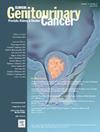用抗体-药物偶联物靶向KIT治疗嫌色性肾细胞癌
IF 2.7
3区 医学
Q3 ONCOLOGY
引用次数: 0
摘要
嫌色性肾细胞癌(ChRCC)是第三种最常见的肾细胞癌。转移性ChRCC患者的中位生存期为27个月,目前尚无证实的治疗方法。KIT (CD117)是一种膜相关酪氨酸激酶受体。靶向KIT的抗体-药物偶联物(ADC)先前在KIT阳性癌症的临床前模型中被发现是安全有效的,但尚未在ChRCC中进行测试。结果在肿瘤基因组图谱中,KIT mRNA在ChRCC中的表达高于其他任何肿瘤类型,平均表达量是匹配正常肾脏的12倍。在我们机构的15例转移性ChRCC标本中,87%为KIT阳性。在单细胞RNA测序数据中,KIT和KIT配体SCF在ChRCC肿瘤细胞中共表达。我们发现,与透明细胞肾细胞癌(ccRCC)衍生细胞和正常肾细胞相比,KIT mRNA在chrcc衍生细胞中的表达明显更高。Western blot分析证实KIT在5株ChRCC细胞系中表达。尽管KIT高表达,但敲低KIT或KIT靶向酪氨酸激酶抑制剂治疗并没有降低ChRCC细胞的增殖。LOP628是一种KIT ADC,可使chrcc来源的细胞活力降低约60%,而对ccRCC细胞没有影响。综上所述,这些数据表明KIT是抗体-药物偶联物在ChRCC中可行的治疗靶点,为进一步研究KIT靶向治疗提供了基础。本文章由计算机程序翻译,如有差异,请以英文原文为准。
Targeting KIT With Antibody-Drug Conjugates in Chromophobe Renal Cell Carcinoma
Introduction
Chromophobe renal cell carcinoma (ChRCC) is the third most common type of RCC. There are no proven therapies for patients with metastatic ChRCC, with a median survival of 27 months. KIT (CD117) is a membrane-associated tyrosine kinase receptor. Antibody-drug conjugates (ADC) targeting KIT were previously found to be safe and effective in preclinical models of KIT-positive cancers but have not been tested in ChRCC.
Results
In The Cancer Genome Atlas, KIT mRNA expression is higher in ChRCC than any other tumor type with the mean expression 12 times higher than matched normal kidney. Of the 15 metastatic ChRCC specimens stained for KIT at our institution, 87% were positive. In single-cell RNA sequencing data, KIT and SCF, the KIT ligand, are co-expressed in ChRCC tumor cells.
We found that KIT mRNA expression is significantly higher in ChRCC-derived cells compared to clear cell renal cell carcinoma (ccRCC)-derived cells and normal kidney cells. Western blot analysis confirmed KIT expression in 5 ChRCC cell lines. Despite high KIT expression, knockdown of KIT or treatment with KIT targeting tyrosine kinase inhibitors did not decrease ChRCC cell proliferation.
LOP628, a KIT ADC, decreased the viability of the ChRCC-derived cells by ∼60% with no effect on ccRCC cells.
Conclusion
Together, these data demonstrate that KIT is a viable therapeutic target for antibody-drug conjugates in ChRCC, providing a foundation for further investigation into KIT-targeted therapies.
求助全文
通过发布文献求助,成功后即可免费获取论文全文。
去求助
来源期刊

Clinical genitourinary cancer
医学-泌尿学与肾脏学
CiteScore
5.20
自引率
6.20%
发文量
201
审稿时长
54 days
期刊介绍:
Clinical Genitourinary Cancer is a peer-reviewed journal that publishes original articles describing various aspects of clinical and translational research in genitourinary cancers. Clinical Genitourinary Cancer is devoted to articles on detection, diagnosis, prevention, and treatment of genitourinary cancers. The main emphasis is on recent scientific developments in all areas related to genitourinary malignancies. Specific areas of interest include clinical research and mechanistic approaches; drug sensitivity and resistance; gene and antisense therapy; pathology, markers, and prognostic indicators; chemoprevention strategies; multimodality therapy; and integration of various approaches.
 求助内容:
求助内容: 应助结果提醒方式:
应助结果提醒方式:


